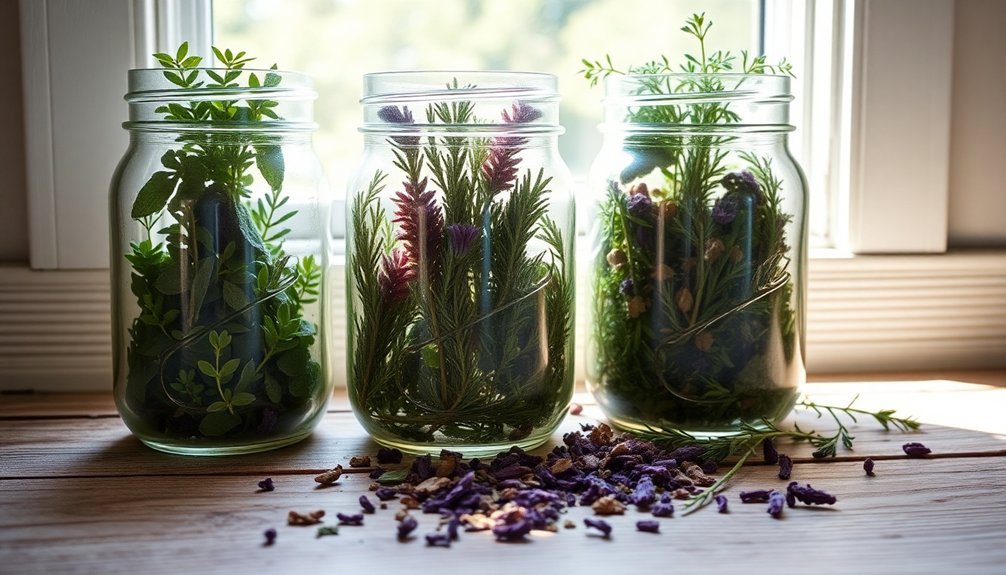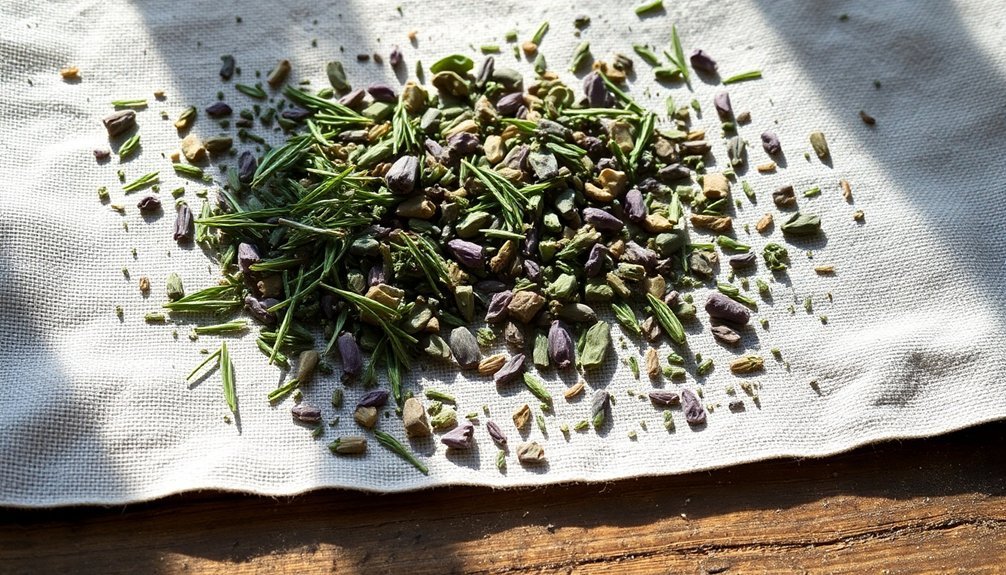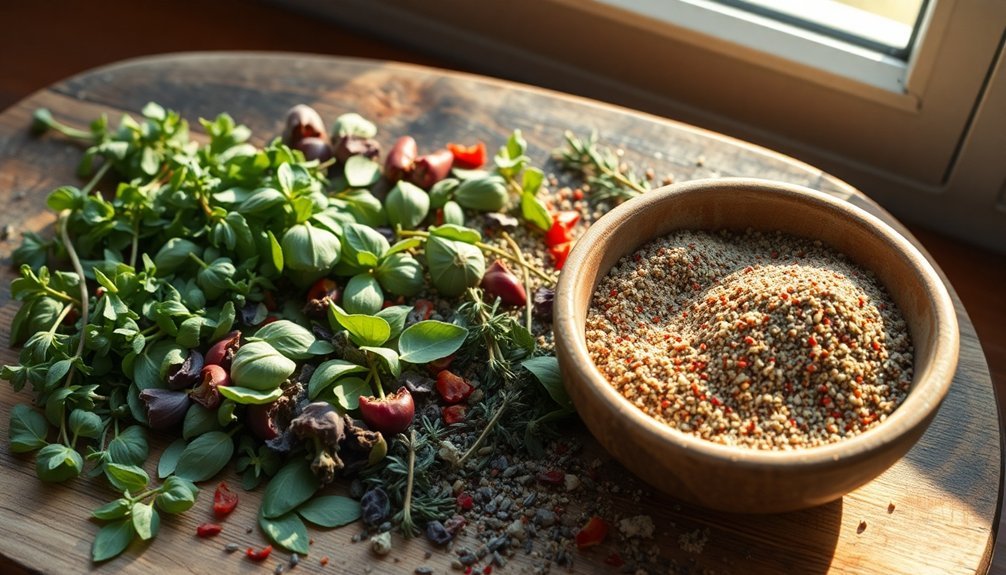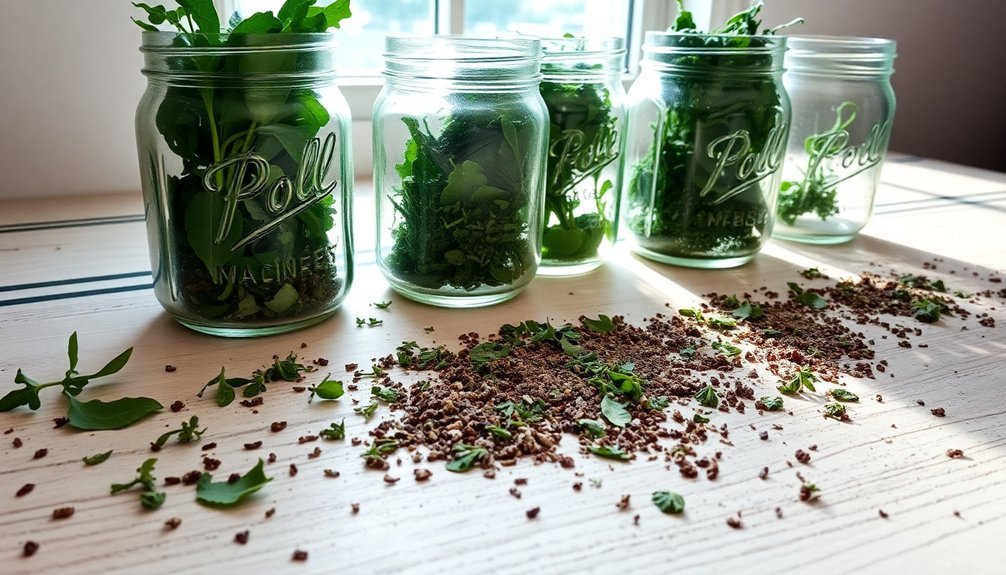You can create flavorful herb blends at home using natural sunlight to dry fresh herbs from your garden. Start by setting up a well-ventilated drying area with partial shade and good airflow. Once your herbs are properly dried, craft classic combinations like Mediterranean (oregano, thyme, basil), French bouquet (parsley, thyme, bay leaf), or zesty pizza seasoning (oregano, basil, garlic). Store your blends in dark glass jars away from heat and light to maintain freshness for up to six months. With proper timing and technique, you'll save money while capturing the peak flavors of summer herbs in your custom spice blends. Discover how simple techniques can transform your garden's bounty into gourmet seasonings.
Planning Your Solar Drying Setup

When setting up a solar drying system for herbs, you'll need to carefully consider both location and structure to guarantee ideal results.
Choose a spot with good air circulation and partial shade, or install a 50% shade cloth to protect sensitive herbs from harsh UV rays. If you're in a humid climate, prioritize areas with lower moisture levels to speed up the drying process.
For your drying structure, build a simple hoop house using metal or PVC pipes covered with greenhouse plastic. The setup is highly cost-effective since you can build multiple drying racks for about $14 each.
Add landscape fabric along the sides and include cross-ventilation windows to maintain proper airflow. Don't forget to incorporate wire benches or screens for laying out your herbs.
Make sure your structure includes support beams to withstand wind, and consider adding a door frame for easy access and additional stability.
Basic Mediterranean Blend
Your Mediterranean blend begins with selecting key herbs like oregano and thyme, which you'll want to dry thoroughly before mixing.
You'll achieve the best results by properly drying your herbs at consistent temperatures and checking for complete moisture removal before combining them with spices like garlic powder and smoked paprika. This blend has earned 3.83 out of 5 stars from home cooks who appreciate its versatility.
For long-lasting flavor, store your finished blend in an airtight container away from light and heat, checking periodically for freshness over its one-to-six-month shelf life.
Herb Selection Guide
The art of crafting a perfect Mediterranean herb blend begins with selecting the right combination of dried herbs and spices.
You'll want to start with five core herbs: oregano (preferably Italian), thyme, basil, rosemary, and parsley. These form the foundation of your blend's authentic Mediterranean flavor profile.
To enhance the depth, add garlic and onion powder for savory notes. For optimal freshness and flavor, store the blend in an airtight container in a cool, dark place.
You can customize your blend by incorporating optional ingredients like dried dill, marjoram, or lemon peel. For additional warmth and complexity, consider including ground black pepper, sea salt, or smoked paprika.
If you're feeling adventurous, try adding a pinch of cumin or cinnamon.
Essential Drying Tips
Successfully drying herbs starts with proper harvesting techniques. You'll want to gather your herbs in the morning after the dew evaporates but before the day gets too hot. Cut stems just above a leaf node, leaving 4-6 inches for regrowth, and select only the healthiest plants before flowers open.
Before drying, clean your herbs by washing in cold water or gently brushing them off. Remove excess moisture using a salad spinner or pat them dry with a towel. Strip lower leaves from stems and discard any damaged foliage. A dehydrator is not required since natural air drying works effectively for most herbs.
Tie small bundles with twine and hang them upside down in a dark, well-ventilated space. Don't place them near moisture sources like sinks or stoves.
While drying can take several days to weeks, you'll need to check regularly for mold formation.
Storage Methods Matter
Proper storage techniques can make or break your dried herb collection, especially when creating versatile blends like a Mediterranean mix. You'll want to keep your herbs in airtight containers stored in a cool, dry place between 60-70°F.
| Storage Element | Best Practice |
|---|---|
| Container Type | Ceramic or dark glass jars |
| Location | Pantry or spice cabinet |
| Temperature | 60-70°F |
| Light Exposure | Minimal to none |
| Duration | Up to 1 year |
For the longest-lasting results, store your herbs whole rather than crushed, and only crumble them when you're ready to use them. Always label your containers with the herb name and date, and remember to check the aroma periodically – a strong scent means your herbs are still fresh and flavorful.
Aromatic French Bouquet Mix

Creating your own aromatic French bouquet mix brings traditional Gallic flavors into your kitchen while offering flexibility in herb combinations.
You'll want to start with the classic trio of parsley, thyme, and bay leaf as your foundation, then customize based on your preferences. When using dried herbs, store them in airtight containers and remember they'll stay fresh for about two months.
- Combine dried parsley, thyme, and bay leaf with optional black peppercorns for a traditional blend
- Experiment with regional variations by adding rosemary for Italian flair or lavender for Provençal touch
- Package your herbs in cheesecloth or tie fresh bundles with kitchen twine for easy removal from soups and stews
Consider scaling your quantities based on serving sizes and storage needs.
You'll find this versatile blend enhances everything from stocks to casseroles with authentic French character.
Southwest Desert Spice Blend
While traditional Mexican seasonings are well-known, the Southwest Desert Spice Blend offers a unique smoky and earthy profile that sets it apart from standard taco or fajita mixes.
You'll combine chili powder as your base with smoked paprika, garlic powder, onion powder, and cumin for a robust foundation. For additional complexity, you can incorporate chipotle powder, dried cilantro, oregano, black pepper, or dried lemon zest.
Mix your ingredients thoroughly and store them in an airtight container. You'll want to use 1-2 tablespoons per pound of meat, but don't hesitate to adjust to your taste.
This versatile blend works beautifully on chicken, seafood, beef, pork, and even roasted vegetables. While it maintains its peak flavor for six months, you can store it for up to a year.
Garden Fresh Pizza Seasoning

Pizza lovers can elevate their favorite Italian dishes with a homemade Garden Fresh Pizza Seasoning that captures the essence of traditional Mediterranean herbs.
This versatile blend combines dried oregano, basil, onion flakes, garlic powder, and thyme for an authentic taste that'll transform your homemade pizzas.
- Add crushed red pepper flakes and smoked paprika to create a spicier, more complex flavor profile.
- Mix the herbs thoroughly with a whisk or process them in a food processor for a finer consistency.
- Store your blend in an airtight container for up to 6 months to maintain ideal freshness.
You can use this seasoning mix in your pizza dough, sauce, or as a finishing touch.
For extra richness, try incorporating grated Parmesan cheese or fennel seeds into your custom blend.
Sun-Dried Herb Storage
To maintain the flavor and potency of your sun-dried herbs, proper storage techniques are vital.
Start by selecting airtight, vapor-proof containers, preferably dark-colored glass jars that'll block out light. Mason jars or spice jars work perfectly, but make sure they're clean and completely dry before use.
Store your herbs in a cool, dry location away from heat sources and humidity. A pantry, cupboard, or root cellar makes an ideal spot.
You'll want to keep them out of direct sunlight and away from steamy areas like bathrooms or stovetops. The heat can quickly destroy your herbs' oils, flavor, and nutrients.
Before storing, verify your herbs are thoroughly dried – they should crumble easily.
When stored correctly, they'll maintain their quality for up to a year. Check freshness by their aroma.
Seasonal Drying Calendar

Since successful herb drying depends on timing, following a seasonal calendar will maximize your harvest's quality and yield.
You'll want to harvest cool-season herbs like cilantro and parsley in spring before they bolt, while gathering warm-season varieties like basil throughout summer. For the best results, collect herbs in the early morning after dew evaporates but before intense sun exposure.
- Cool-season herbs need complete harvesting before they become bitter
- Warm-season herbs can be harvested continuously, taking no more than one-third of the plant
- Perennials require their final big harvest two months before frost
Remember to adjust your calendar based on your climate zone and specific herbs.
For perennials like oregano and sage, maintain light harvesting after the main harvest until frost arrives. Annual herbs need complete harvesting before the first frost since they won't regrow.
Frequently Asked Questions
How Do You Protect Drying Herbs From Insects Without Using Chemicals?
You'll protect drying herbs from insects by heat-treating them at 160°F, hanging bundles in paper bags with air holes, using screens for small leaves, and storing them in airtight containers in clean spaces.
Can Herbs Be Dried in Partial Shade or Only Direct Sunlight?
You can successfully dry herbs in both partial shade and direct sunlight. Partial shade's actually ideal for delicate herbs like thyme and cilantro, while hardier herbs like rosemary can handle full sun exposure.
What Signs Indicate Herbs Are Over-Dried and Have Lost Their Flavor?
You'll notice over-dried herbs lack aroma when crushed, show dull or faded colors instead of vibrant hues, and crumble too easily. They'll taste bland, requiring larger amounts to achieve the desired flavor impact.
Should Stems Be Removed Before or After the Drying Process?
You'll want to keep stems on during drying and remove them afterwards. This preserves essential oils, makes handling easier, and guarantees better flavor retention. Plus, you'll find it's much simpler to strip dried leaves.
How Do Different Weather Conditions Affect Natural Drying Times?
You'll find your herbs dry faster in warm, low-humidity conditions with good airflow. High humidity slows drying and risks mold, while hot temperatures above 100°F can speed drying but may damage flavor and color.
In Summary
You'll find these homemade solar-dried herb blends bring fresh, vibrant flavors to your cooking year-round. Once you've mastered the basic drying techniques and timing, you can experiment with your own signature combinations. Just remember to store your dried herbs in airtight containers away from light and heat. With proper care, your sun-dried blends will maintain their potency for up to 12 months.





Leave a Reply